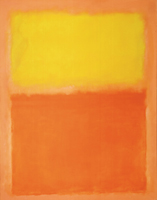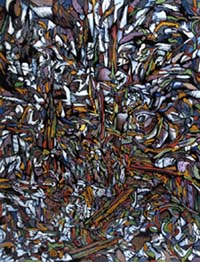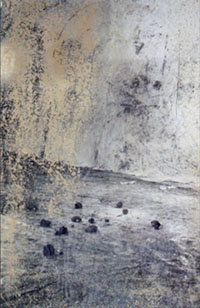| Introduction |
 |
|
 With this edition, the ARAS Online Newsletter is officially morphing into the ARAS/Art and Psyche Online Journal. You will notice there are two changes in the name of this publication. The first is that ARAS is teaming up with the Art and Psyche Working Group to publish the papers from the "Art and Psyche: Reflections on Image Conference" that was held in San Francisco in May, 2008. The goal of the conference was to create a dialogue between many different kinds of people who are interested in the intersection between art and psychology. Artists were joined by art therapists; art historians were joined by art critics; Jungian analysts were joined by analysts from other traditions. The papers from this conference have been collected and will be published here over time -- slowly so that there is time to digest the wonderfully varied contributions. The second change in this publication's name is that we are now calling ourselves a "journal" rather than a "newsletter." This is a bit ambitious for where we are now, but it reflects our desire to create a forum in which the exchange of ideas and the presentation of articles on the relationship between art and psyche, between art and archetype, and between art from the ages and contemporary art have a chance to mingle in a creative exchange about the interplay of art in culture, religion and psychology. With this edition, the ARAS Online Newsletter is officially morphing into the ARAS/Art and Psyche Online Journal. You will notice there are two changes in the name of this publication. The first is that ARAS is teaming up with the Art and Psyche Working Group to publish the papers from the "Art and Psyche: Reflections on Image Conference" that was held in San Francisco in May, 2008. The goal of the conference was to create a dialogue between many different kinds of people who are interested in the intersection between art and psychology. Artists were joined by art therapists; art historians were joined by art critics; Jungian analysts were joined by analysts from other traditions. The papers from this conference have been collected and will be published here over time -- slowly so that there is time to digest the wonderfully varied contributions. The second change in this publication's name is that we are now calling ourselves a "journal" rather than a "newsletter." This is a bit ambitious for where we are now, but it reflects our desire to create a forum in which the exchange of ideas and the presentation of articles on the relationship between art and psyche, between art and archetype, and between art from the ages and contemporary art have a chance to mingle in a creative exchange about the interplay of art in culture, religion and psychology.
We are particularly pleased that we are going to be able to offer subscriptions to the new journal at no cost. In a time of economic downturn, free is good. We encourage you to tell your friends and colleagues about this new feature of the ARAS Online site and let them know that they can subscribe for free. We are also very excited that ARAS and the Art and Psyche Working Group have joined in this experiment to create a journal of exchange. It has great promise and with the papers from the Art and Psyche conference it has a great foundation on which to build.
Best wishes,
Tom Singer, M.D.
Co-Chair of ARAS Online for National ARAS
|
 
The Art and Psyche Working Group |
 |
 Welcome to the newly named ARAS/Art and Psyche Online Journal. The Art and Psyche Working Group in collaboration with ARAS will be publishing papers produced for the "Art and Psyche: Reflections on Image Conference" held in San Francisco in May 2008 which was jointly sponsored by the C. G. Jung Institute of San Francisco and supported by the van Waveren Foundation. After investigating various methods of publishing the papers, the advantages of going online became abundantly clear to us. Not only is it affordable, but it allows us to publish all of the papers over time and most importantly, we can include as many color images as needed. ARAS has generously made producing this project possible and, amazingly, they will be offering the journal free of charge to anyone interested in subscribing. To start, we will publish at least two papers per quarterly issue with the hope of adding book and film reviews written by analysts, art historians, artists, curators and any therapist with a depth psychological view. With the capacity to present multiple images, we also hope to offer online gallery shows and commentary. Welcome to the newly named ARAS/Art and Psyche Online Journal. The Art and Psyche Working Group in collaboration with ARAS will be publishing papers produced for the "Art and Psyche: Reflections on Image Conference" held in San Francisco in May 2008 which was jointly sponsored by the C. G. Jung Institute of San Francisco and supported by the van Waveren Foundation. After investigating various methods of publishing the papers, the advantages of going online became abundantly clear to us. Not only is it affordable, but it allows us to publish all of the papers over time and most importantly, we can include as many color images as needed. ARAS has generously made producing this project possible and, amazingly, they will be offering the journal free of charge to anyone interested in subscribing. To start, we will publish at least two papers per quarterly issue with the hope of adding book and film reviews written by analysts, art historians, artists, curators and any therapist with a depth psychological view. With the capacity to present multiple images, we also hope to offer online gallery shows and commentary.
We are delighted to begin with papers by Diane Fremont, a Jungian analyst and member of the Jungian Psychoanalytic Association of New York and by David Parker, an artist and professor from the United Kingdom. Diane has elegantly woven together her poetic writing with stunning images. Through word and his own painted images, David has invited us into the psychological process of his creative work. No doubt, you will find these presentations to be engaging at multiple levels.
If you are not already a subscriber, we hope that you do sign up. We are thrilled to inaugurate this new joint venture and welcome you to The ARAS/Art and Psyche Online Journal.
With all good wishes,
Linda Carter
The Art and Psyche Working Group |
Send Us Your Questions |
 |
| If you have questions about specific images, searching, how to use ARAS, or archetypal symbolism in general, please email them to us at info@aras.org. |
|
 |
|
The Abstract Unconscious in Painting
|
 |
An excerpt from The Abstract Unconscious in Painting, by David Parker

Eye of Faith
David Parker |
'…it is only as an aesthetic phenomenon that existence and the world are eternally justified…' (Nietzsche. F. 1872)
I will begin by stating that, for me, what takes place in the studio, and subsequent reflections on the activity and its outcomes, appears to be deeply connected to a vital personal need to engage in some form of highly altered state of mind. Such a need is curiously demanding and inevitably complex in terms of potential meaning - being intensely bound up with formal visual issues and imaginative responses to the developing image.
What is becoming clear, as my experience and conscious understanding develops, is that both process and product appear to be driven by inner (perhaps unconscious) needs - needs that are essentially manifested through highly concentrated perceptual fantasies. Such fantasies on face value seem to be, in effect, what I will call 'hermetic constructs' - having no clear symbolic connection to the external world as such or, apparently, any shared cultural connection beyond the obvious one of earlier experiments in modernist abstraction.
In this sense the work appears to be, in practice, intensely introverted – perhaps even bordering on the autistic. That said the imagery does seem to carry a level of aesthetic meaning and value, a value rooted somewhere other than any associations that might be made with shared, externally validated, sources of recognition. What then perhaps needs to be addressed from the outset, concerns what such implied inner needs might be, as it seems that these needs drive the initial intention to physically create an image and to act this out imaginatively through a highly specific process of change and development.
Read the entire paper. |
|
The Visible and the Invisible in Art
|
 |
An excerpt from The Visible and the Invisible in Art: the Secret Space of the Image by Diane Fremont

Sephiroth
Anselm Kiefer |
|
|

Sephiroth
Anselm Kiefer |
|
"There is a secret stone, hidden in a deep well
Worthless and rejected, concealed in dung or filth
And this stone is a bird, and neither stone nor bird…"
(Mylius, quoted in Jung, 1963, note 441, p. 194)
In certain works of art, the numinous quality comes not through content, likeness to reality, perfection of technique or composition, but rather through the vagaries of the process itself, unfinished and imperfect. The tension of this imperfection is then held invisibly and secretly in the image until the viewer comes along to privately open and engage it in the viewing, and that uncompleted, never ending process comes to life, drawing the viewer into its participatory space. This mysterious quality does not track any direct line through art history, but follows a fine, supple thread, leaping across continents, centuries and even millennia.
Works that capture this quality share an affinity or correspondence that doesn't respect mundane time, space, logic, or personal tastes and aesthetic preferences, but rather, connects to the timeless god-like quality in each of us, that essential being at our very core. We occasionally catch a glimpse of this Being, reflected sometimes in nature, sometimes in art, like the startled and startling gaze of an animal caught unawares, suddenly looking back at us in recognition. The art critic and novelist, John Berger, suggests that to find this "invisible heaven, one must only lift up something as small and as at hand as a pebble…" Quoting Simone Weil, he says "When we know how to turn whatever happens, no matter what it is, into an object of desire…", this desire "pierces through time to find eternity behind it." (Berger, p. 11)
Read the entire paper. |
 
ARAS Hint: Using ARAS Images Elsewhere |
 |
With so many remarkable images in ARAS spanning different eras and cultures, we're often asked if the images in the archive can be used elsewhere. Alas, there is no simple answer, as it depends very much on the specific image and how you intend to use it.
First, ARAS does not own the copyright to the images in our collection and cannot grant you permission for their use. We also cannot give you legal advice. We instead recommend that you consult a copyright attorney if you seek to reuse images from our archive.
You'll find that many ARAS images are already in the public domain, which means that they do not have a valid copyright. You can use such images without restrictions. Public domain images include photographs taken before 1923, as any copyright that old has expired by now. Similarly, images that were never copyrighted (before copyright became automatic on March 1, 1989) and images whose copyrights weren't renewed when required to be are also in the public domain. In addition, copyrighted images must contain some original content. Many ARAS images are of images or artwork much older than 1923, so unless a photograph of them adds an interpretation or uses a specifically-chosen angle or lighting, the photograph itself is also generally in the public domain.
When ARAS images aren't in the public domain, the fair use doctrine sometimes allows you to make copies without seeking permission. There are no absolute rules as to what the doctrine permits, but it normally covers personal, research, and educational situations, favors non-profit over commercial use, and considers the economic impact on the copyright owner. For example, the fair use doctrine is likely to allow you to give copies of an image to a few students at a non-profit college. On the other hand, publishing the same image in a commercially-sold textbook is not likely to be fair use and you'll need to secure permission from the copyright owner.
As you can see, the rules for determining when you can use an image without seeking permission are complex. That's why we recommend you contact a copyright attorney for assistance with your particular situation. The discussion above covers copyright rules only in the United States - different rules apply in other countries. |
|

